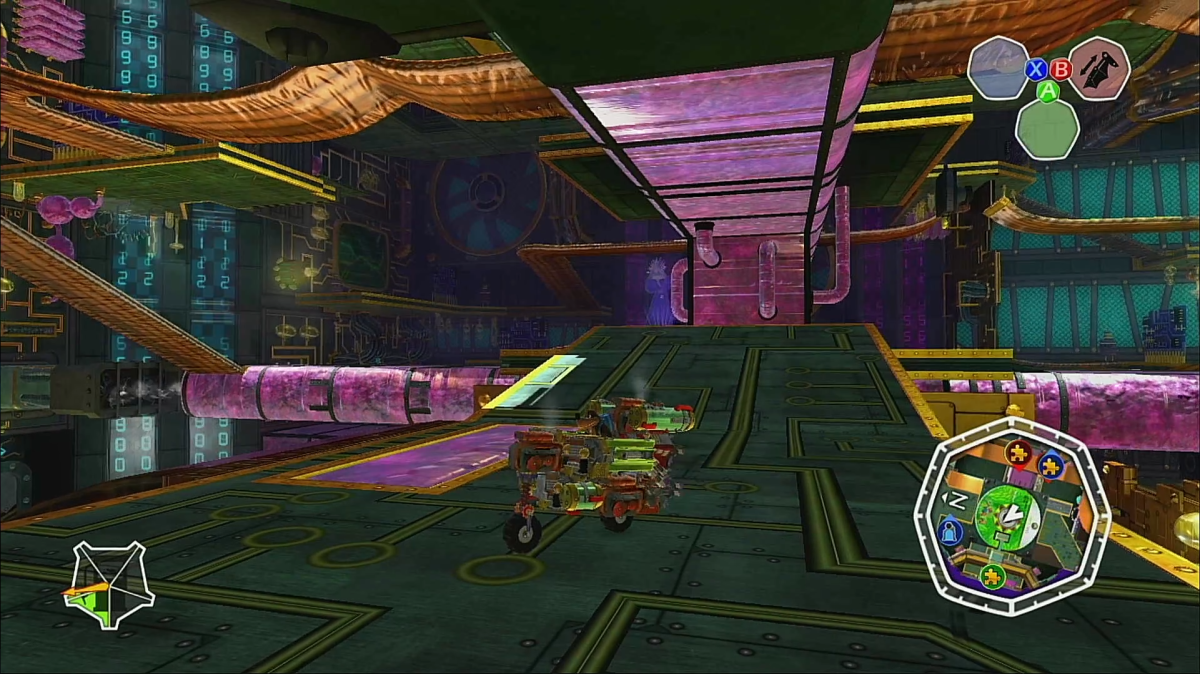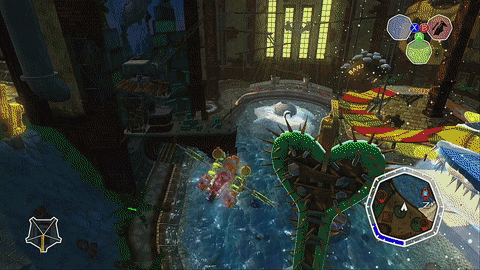Banjo-Kazooie: Nuts & Bolts’ second level, Logbox 720, takes place inside a fictional videogame console, where players can ride ribbon cable roads up its many levels, swim down coolant tubes, and ride spinning discs featuring other Rare games such as the original Banjo-Kazooie. Inside they are tasked with completing challenges including repairing an antenna and rescuing engineers from a deadly firewall, armed with any vehicle, from cars to planes and mechs, that they can build. Not only is this is a great showcase of how videogames are stripped down simulations of the real physical world generated by electronic architecture, Nuts & Bolts teaches engineering principles by providing a powerful workshop and rewards thinking outside its virtual box.
The world is a puzzle box that is solved from the inside, a place filled with opportunities and limitations, including universal systems that govern it and the objects inside. You cannot defy the physics that hold existence together, but you can use the tools within it and engineering is the attempt to combine all its objects and parts to overcome challenges. Since the virtual environments in videogames are operating systems with immeasurably smaller processing power than, ya know, reality, they are even more constrained, and so players only have access to the tools and physics that the software has implemented for them; you can only go where, do what, and interact as, the game allows, so it can maintain its internal integrity. But Nuts & Bolts is special because it wants you to experiment with its systems and combine parts to break its rules as creatively as you can.
With Banjo-Kazooie, Rare created worlds packed with tasks that matched the large range of moves that were possible because you controlled a bear with a bird strapped to its back. Nuts & Bolts tackles the challenge-based structure in a unique, free form way by letting you build any custom vehicle you think will get the job done. Its challenges are really pretty simple, ranging from delivering an object to a point within a time limit to tests of strength forcing an object out of bounds or just straight up race other characters. Really, the only limits you have to accomplish any task are the parts you currently have in your box and the physics system trying to keep you grounded.
Like any good engineer, your design process to best these challenges comes down to three equally important phases: prototyping, testing, and revising.
Prototyping:
No tool is appropriate for every job, so when you load into the workshop to start developing you will need to design your vehicle with purpose. Are you carrying an item? Pushing something? Racing? The game starts you off with a set of basic wheels. Of course, wheels won’t spin without a motor which can’t be powered without a fuel source, so you will need to connect each these parts in a configuration that includes your driver’s seat. As with real vehicles, the larger and heavier the frame is, the more force is needed to move it so you may have a couple motors, and since each motor uses its own fuel you will need enough tanks to keep it supplied.
Now, this kind of gameplay could get really complicated really quickly, but Nuts & Bolts wisely makes the build process as simple as possible by going with a design philosophy that says that if a part is touching the vehicle in any way, then it’s completely linked to the system- you don’t need to have a motor in line with the wheels or anything like that. Instead, the game takes a snap-and-go Lego block approach, using a cube as the standard size for every part, with most parts taking up at least a few blocks of space. But as long as all the parts are connected to the vehicle in some way, it will work, and so your frame builds out with every piece that gets added.
One of the amazing things about N&B’s gameplay is that swapping out some parts for others can radically change how your ride functions without having to completely start a design from step one. Swap those wheels out for a few propellers and you will have a helicopter. Add a few egg guns and ammo crates and you have a yolk-shooting turret, or add a magnetic tow and pull a trailer. There are so many seemingly small options that can massively change a vehicle’s function that you can experiment without ruining your original design, and each can be saved as its own blueprint so you can quickly rebuild it for any new challenge that gets thrown in your path.
Testing:
Almost any design looks good on paper, but the testing environment is a great place to see how well your vehicle performs under stress, and for a game like Nuts & Bolts, it’s crucial that the physics and collision systems have been designed to properly simulate real world cause and effect. This means that the game needs to be able to calculate universal elements like weight, force, momentum, and traction so that their designs will accurately react when imported into worlds with different ramps, terrain, and objects that the player can hit.
Given these physical considerations, the vehicle’s frame needs to be laid out so that the control is balanced properly. Put too much weight on any side and it will tip forwards or back or tilt left or right, completely throwing off the weight distribution so it becomes an uncontrollable brick. So try adding support wheels to counterbalance a car, but you can make some pretty cool motorcycles by attaching all your major parts in a symmetrical straight line and letting the entire frame balance itself. Something worth noting is that vehicle engineering issues can be corrected by having a skilled person controlling it, meaning that it’s the combination of design and input that makes a tool successful. Overall, what’s important is that the game lets your vehicle fail in realistic ways so that you can learn where your design went wrong and how to correct it.
A great place to test your design is Banjoland, a museum featuring paraphernalia and locations taken from the original two Banjo-Kazooie games. If you have explored the overworld and scavenged its hidden part crates, you can come into Banjoland with a planes and submarine, perfect for exploring the high ceilings and underwater locations for all the hard to reach notes. This world does a great job reminding you not only of how the series has progressed and built on its objective-based structure, but how the new gameplay adds breath to the verticality and depth of the series. But if the things you build aren’t up to the task at hand, it’s simple to jump back into the workshop and start tweaking the design until it can defeat any challenge efficiently.
Revising:
For many people the design process can be intimidating, so Nuts & Bolts helpfully throws premade schematics your way that can solve many of these challenges, but there is a lot of benefit to going in and manually tweaking your project until it’s exactly what you want. The brilliance of the structure is that its scenarios can be completed as many times and in any way that the player wants, and as every puzzle piece has three tiers of prizes depending on how quickly or thoroughly you earn it, the game rewards constant revision as your vehicle approaches perfection. Also important is that these scenarios remain the same no matter what vehicle you enter for it. A race filled with obstacles may be challenging by land but it’s easier if you put some jump springs under your chassis so it can just bounce over them and even easier if you strap a pair of wings on the side and make a beeline for the finish. The game is meant to be broken and rewards smart engineering.
As revision is an act of transformation, making a vehicle lighter and more agile or heavier so it can throw its weight around. But devices like the retractable wings mean that every vehicle can be a double or triple changer, giving you full ground control when they are folded in and aerial acrobatics when extended, and the scuba seat lets you dive into a body of water to continue below. The game is powerful enough that you can nimbly shift gears and change how your gear functions and seamlessly transitions between environments with their different gravity and resistances.
With customizability comes variety, and the staggering amount of ways vehicle parts can be put together in Nuts & Bolts means that it can replicate a large range of scenarios as well. In a way, the entire game is a revision of 3D platformers, rearranging each of the elements into a completely new thing. It means that a 3D platformer can become a traditional sport like soccer or basketball, a frenetic racer like Diddy Kong Racing or Crazy Taxi, or a Twisted Metal-style destruction derby. It has the parts required to build these game types and more, they just needs to be assembled correctly.
When you have completed the main game and acquired all the parts and designs, the last remaining place to test your creations is the multiplayer arena. There, you will see creativity put on display and see the infinite combinations those parts can be put in as you compete against amazing vehicles that have found unique ways of overcoming challenges, and may very adopt ideas back into your design. While Banjo-Kazooie: Nuts & Bolts lets players explore the principles of engineering in its virtual worlds, the sense of creative wonder it sparks can be brought back to redesign the real world in new forms as vast as the imagination.
DEVELOPER: Rare
PLATFORM: Xbox360
2008
Dane Thomsen is the author of ZIGZAG, a sport-punk adventure in a world of electrifying mystery. With the voice of her people as her guide, Alex walks neon purple streets thrown into chaos, wielding the concussive force of her baseball bat the mighty ‘.357’ against the forces of evil. Print and kindle editions are available on Amazon. For sample chapters and to see his other works please check out his blog.




